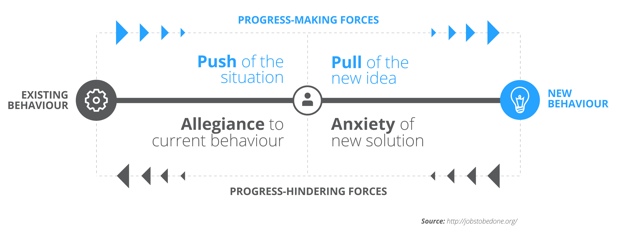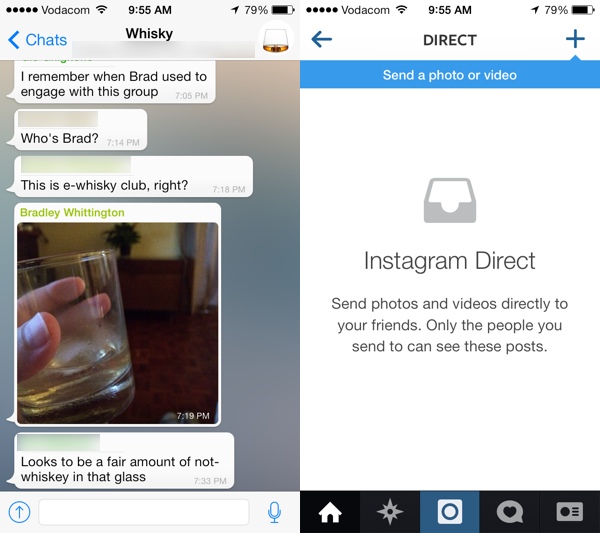A few months ago I wrote about the forces at work when people choose a product. I discussed the Jobs-To-Be-Done concept of Progress-Making Forces, and shared this diagram to illustrate what happens when we try to get people to use our product instead of someone else’s:

In this article I want to discuss this framework in the context of a practical example: WhatsApp vs. Instagram Direct (now both owned by Facebook). I started thinking about this recently after MG Siegler wrote his post Going Against The Grain:
We’re seeing over and over again now that the behemoths can’t simply add a startup’s functionality into their own app as a feature and kill said startup. But it’s equally important to note that if you are able to establish your startup, especially those in app form, it may be hard to get your users to do anything other than what they originally came to do. Especially if the new functionality is against the grain in any way.
So, let’s consider this statement in the context of the Progress-Making Forces, and apply it to Instagram’s decision to add private photo sharing with Instagram Direct. First, let’s talk about existing photo sharing behavior. How do people currently send photos to each other? Facebook used to be the king of photos, but people are increasingly using messaging apps for this instead:
WhatsApp is processing 500 million images per day, compared to 400 million Snapchat (“snaps”) per day, which could include photos or videos. For its part, Facebook processes a comparatively paltry 350 million photos a day.
Enter Instagram Direct, a way for Facebook to try to claim back some of the private photo sharing pie. That’s the new behavior in the context of the the forces diagram. So the big question for Facebook is this: How do you get people to move their private photo sharing from WhatsApp (existing behavior) to Instagram (new behavior)? According to our framework, the progress-making forces need to be stronger than the progress-hindering forces, so let’s look at each force in turn:
- Push of the situation. Is there anything people are not able to do by sending photos through WhatsApp that they wish they could do? It doesn’t seem that way. Some of the biggest advantages of using WhatsApp for photos are that (1) it’s completely private, and (2) it ties into your phone’s camera roll, so you have access to any photo, not just the ones from a particular app.
- Pull of the new idea. Is there anything in Instagram Direct that could entice people away from WhatsApp? Again, it doesn’t look like it. Using Instagram Direct is simply more work than using WhatsApp for photos. If the photo isn’t in Instagram yet you have to import it. You have to apply a filter because that’s what you do in Instagram. Only then can you send it. But then the entire conversation is centered around photos. You still have to use WhatsApp for text messaging. So now you’re communication is fragmented, while it’s all seamlessly integrated in WhatsApp. There’s no pull here.
- Allegiance to current behavior. How strongly are people attached to their WhatsApp experience? Extremely. The benefits of having all conversations and photos centrally located in WhatsApp can’t be overstated. You’re not just sending photos, you’re talking about life. It becomes a timeline of your relationships, and everything is there.
- Anxiety of new solution. How worried are people that the shift would ruin their experience? Well, it seems there would be quite a bit of anxiety involved in moving to a product that doesn’t support the functionality you’re used to, and sits within a walled garden.
This analysis clearly shows that while the progress-making forces for moving people to Instagram Direct are relatively weak, the progress-hindering forces are extremely strong. This keeps people glued to WhatsApp, and it explains Instagram Direct’s apparent failure.
So what happened here? I think Facebook realized that they won’t be able to change people’s existing photo-sharing behavior. And that’s why they bought WhatsApp.
